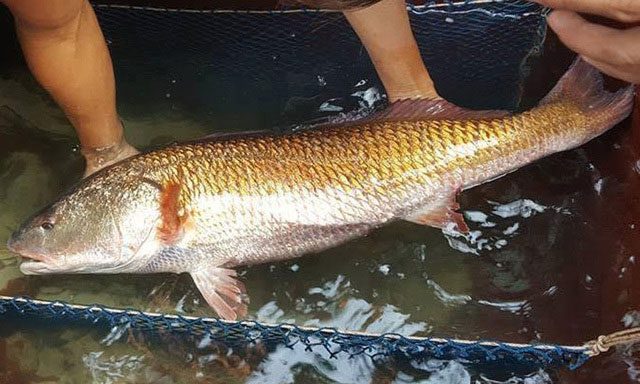Vietnam boasts a rich variety of marine life, including a highly rare fish known as the golden sủ fish, which can reach prices in the billions.
The golden sủ fish (scientific name: Otolithoides biauritus), also known as goldenfin sủ fish, double golden sủ fish, thủ fish, or đường fish, is the largest member of the sciaenid family, belonging to the order Perciformes (family Sciaenidae). This species is found in regions of India, Indonesia, Sri Lanka, China, and Vietnam.
In Vietnam, the golden sủ fish is scattered from the northern to the southern coastal areas. Central provinces like Thanh Hoa and Nghe An also report sightings of this fish, although their numbers have significantly dwindled and they are now rarely seen. However, they have not yet been listed in the Red Book as they can still be caught.

The golden sủ fish is a rare species with high economic value.
According to experts, the golden sủ fish has a pointed snout, a wide mouth, and a yellowish hue, with the lower jaw extending below the eye socket. It has strong teeth and a long dorsal fin. This species resides in the ocean but migrates to brackish river mouths during the spawning seasons (from January to April and September to October of the lunar calendar) to lay eggs.
Young fish swim into freshwater areas deep inland to live, returning to the sea after 1-2 years. Adult fish can reach sizes of up to 160 cm and weigh over 120 kg, with a maximum length of 160 cm.
Depending on their habitat, the head and back of the fish may appear gray or green. Upon death, the fish’s body gradually shifts color from light yellow to dark yellow.
The golden sủ fish primarily feeds on various invertebrates and juvenile fish living at the bottom of the water. They are notoriously difficult to raise in artificial environments, which makes their cultivation for ornamental purposes or conservation extremely challenging.
Explaining the value of the golden sủ fish, Dr. Nguyen Duc Cu from the Institute of Marine Resources and Environment (Vietnam Academy of Science and Technology), who has conducted research on this fish, stated that the immense monetary value does not lie in its flesh or scales but in its swim bladder.
“The swim bladder of the golden sủ fish is used as a material for sutures in medicine. This type of suture can dissolve after being used on a patient,” Dr. Cu explained. A fish weighing 40-50 kg can yield approximately 1 kg of fresh swim bladder.

The mouth of the golden sủ fish has a distinctive yellow color. (Photo: Dai Doan Ket Newspaper).
Additionally, dried swim bladders are considered a highly nutritious food (on par with ginseng due to their benefits for the liver and kidneys). The swim bladder is rich in protein, containing 442 g of protein per 500 g, which helps boost vital energy, enhance blood circulation, and replenish nutrients for those who are weak or anemic. Pregnant women or those who have recently given birth benefit from consuming golden sủ fish, as it provides significant nutritional support. Notably, the Chinese utilize swim bladders in certain traditional remedies, further escalating the value of this fish.
In Vietnam, before 2005, the price of golden sủ fish ranged from 5 to 7 million VND per kg (approximately 300 to 400 USD). By 2007, prices had increased to around 15 to 20 million VND per kg, but today traders can sell these fish for up to billions of VND depending on their weight.
Moreover, according to long-standing Chinese beliefs, dishes made from golden sủ fish are always considered “highly fragrant and delicious.” They believe that this food will bring good fortune and prosperity in business. Previously, golden sủ fish sold for about 15-20 million VND per kg, and now prices can reach 30-40 million VND per kg.
Many unique dishes made from golden sủ fish rank among the top ten most preferred foods in Hong Kong and are among the most expensive worldwide. The Chinese also believe that consuming golden sủ fish brings good luck and prosperity. Additionally, the tough scales of the golden sủ fish are used to create picks for musicians, which are sold in Japan and Europe.
Professor Mai Dinh Yen, a fish expert, further noted that this species is primarily sold to advanced countries such as Japan, the USA, and China—nations that have the technology to produce sutures from fish swim bladders. The hard scales are also utilized to make musical picks.




















































